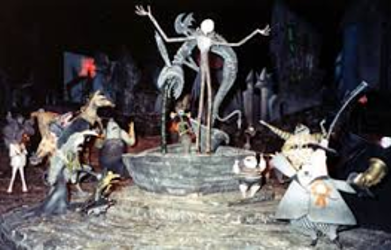

As writer Tim Burton's upbringing in Burbank, California was associated with the feeling of solitude, the filmmaker was largely fascinated by holidays during his childhood. "Anytime there was Christmas or Halloween, it was great. It gave you some sort of texture all of a sudden that wasn't there before", Burton would later recall. After completing his short film Vincent in 1982, Burton, who was then-employed at Walt Disney Feature Animation, wrote a three-page poem titled The Nightmare Before Christmas, drawing inspiration from television specials of Rudolph the Red-Nosed Reindeer, How the Grinch Stole Christmas! and the poem A Visit from St. Nicholas. Burton intended to adapt the poem into a television special with the narration spoken by his favorite actor, Vincent Price, but also considered other options such as a children's book. He created concept art and storyboards for the project in collaboration with Rick Heinrichs, who also sculpted character models; Burton later showed his and Heinrichs' works-in-progress to Henry Selick, also a Disney animator at the time. After the success of Vincent in 1982, Disney started to consider developing The Nightmare Before Christmas as either a short film or 30-minute holiday television special. However, the project's development eventually stalled, as its tone seemed "too weird" to the company. As Disney was unable to "offer his nocturnal loners enough scope", Burton was fired from the studio in 1984, and went on to direct the commercially successful films Beetlejuice and Batman. Over the years, Burton regularly thought about the project. In 1990, Burton found out that Disney still owned the film rights. He and Selick committed to produce a full-length film with the latter as director. Disney was looking forward to Nightmare "to show capabilities of technical and storytelling achievements that were present in Who Framed Roger Rabbit." Nightmare marked Burton's third film in a row to have a Christmas setting. Burton could not direct because of his commitment to Batman Returns and he did not want to be involved with "the painstakingly slow process of stop motion". To adapt his poem into a screenplay, Burton approached Michael McDowell, his collaborator on Beetlejuice. McDowell and Burton experienced creative differences, which convinced Burton to make the film as a musical with lyrics and compositions by frequent collaborator Danny Elfman. Elfman and Burton created a rough storyline and two-thirds of the film's songs. Elfman found writing Nightmare's eleven songs as "one of the easiest jobs I've ever had. I had a lot in common with Jack Skellington." Caroline Thompson still had yet to be hired to write the screenplay. With Thompson's screenplay, Selick stated, "there are very few lines of dialogue that are Caroline's. She became busy on other films and we were constantly rewriting, re-configuring and developing the film visually.
Selick and his team of animators began production in July 1991 in San Francisco, California with a crew of over 120 workers, utilizing 20 sound stages for filming. Joe Ranft was hired from Disney as a storyboard supervisor, while Eric Leighton was hired to supervise animation. At the peak of production, 20 individual stages were simultaneously being used for filming. In total, there were 109,440 frames taken for the film. The work of Ray Harryhausen, Ladislas Starevich, Edward Gorey, Charles Addams, Jan Lenica, Francis Bacon and Wassily Kandinsky influenced the filmmakers. Selick described the production design as akin to a pop-up book. In addition, Selick stated, "When we reach Halloween Town, it's entirely German Expressionism. When Jack enters Christmas Town, it's an outrageous Dr. Seuss-esque setpiece. Finally, when Jack is delivering presents in the 'Real World', everything is plain, simple and perfectly aligned." Vincent Price, Don Ameche, and James Earl Jones were considered to provide the narration for the film's prologue; however, all proved difficult to cast, and the producers instead hired local voice artist, Ed Ivory. On the direction of the film, Selick reflected, "It's as though he laid the egg, and I sat on it and hatched it. He wasn't involved in a hands-on way, but his hand is in it. It was my job to make it look like 'a Tim Burton film', which is not so different from my own films." When asked on Burton's involvement, Selick claimed, "I don't want to take away from Tim, but he was not in San Francisco when we made it. He came up five times over two years, and spent no more than eight or ten days in total." Walt Disney Feature Animation contributed with some use of second-layering traditional animation. Burton found production somewhat difficult because he was directing Batman Returns and in pre-production of Ed Wood. The filmmakers constructed 227 puppets to represent the characters in the movie, with Jack Skellington having "around four hundred heads", allowing the expression of every possible emotion. Sally's mouth movements "were animated through the replacement method. During the animation process, only Sally's face 'mask' was removed in order to preserve the order of her long, red hair. Sally had ten types of faces, each made with a series of eleven expressions (e.g. eyes open and closed, and various facial poses) and synchronized mouth movements."The stop motion figurine of Jack was reused in James and the Giant Peach as Captain Jack.